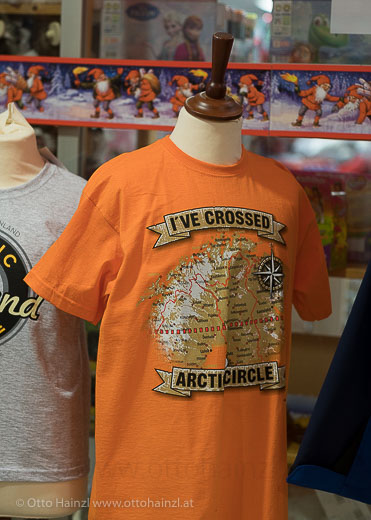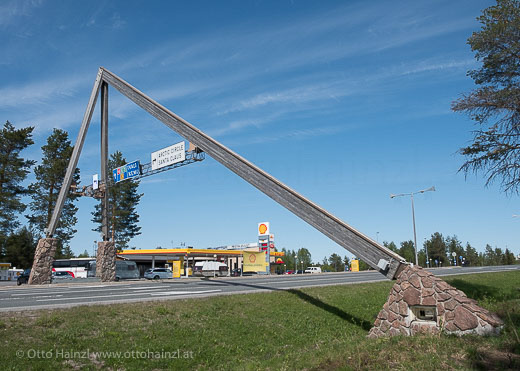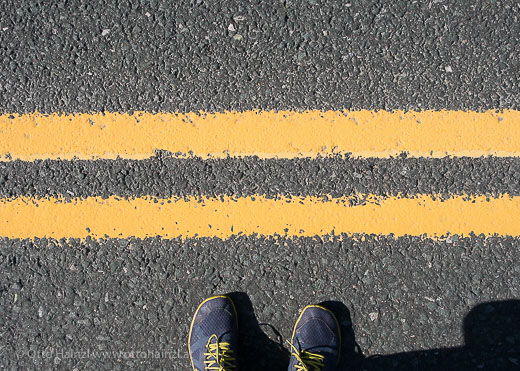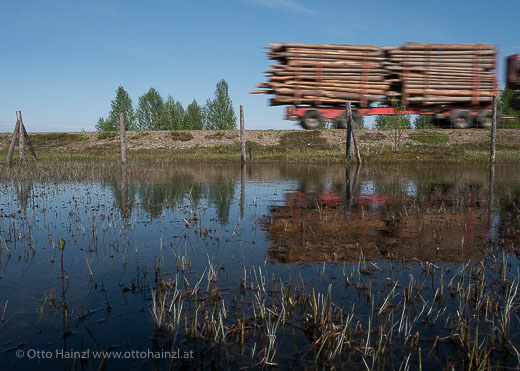
I admit, the thing I’ve been looking forward to most over the past few days has been the Arctic Circle. Not the national parks, not the beautiful lakes, no—the Arctic Circle. All the other sites are secondary.
Signs announce the Arctic Circle many kilometers in advance. Just a few km north of Rovaniemi, the capital of Finnish Lapland, it supposedly crosses the E75. We’ll see.
It doesn’t last long before I come across a sculpture towering over the road—as a symbol of this phenomenon, I suppose. Two hundred meters farther on, an identical sculpture reaches over the opposite lane. That strikes me as strange, because the Arctic Circle can’t be quite that wide. I’ve already been to the Equator, which is relatively thin. The Arctic Circle can’t possibly be thicker.
Directly beside the sculpture and the road, there’s a souvenir outlet. Its length corresponds conspicuously well to the distance between the sculptures. At any rate, it’s quite some outlet. One that need fear no comparison. They even make a thing of St. Nicholas living here, and so on… I find it all a bit much.

But now I have to get to the bottom of this whole thing. And to my great dismay, I ascertain that the Arctic Circle isn’t actually here at all!!! On my Arctic Circle journeys (of which this is my first), I always take along a GPS receiver. This device boasts a precision of 3 meters. And the point where the Arctic Circle crosses the E75 is over four kilometers away from here!
At the souvenir outlet, you can buy certificates stating that you’ve crossed the Arctic Circle, T-shirts that read “I crossed the arctic circle”, and so on, but none of it’s true. Folks who turn back here haven’t even come close to crossing it! How many hundreds or even thousands must there be who possess invalid certificates, so expensively bought! I really don’t want to think about it.
But the issue of the Arctic Circle’s location preoccupies me, and I can only really find one convincing explanation:
just like there’s a geographic North Pole and a magnetic North Pole (the Earth’s axis runs through the geographic one), there’s a geographic Arctic Circle and a touristic Arctic Circle.
The touristic Arctic Circle isn’t a physical phenomenon; it’s an economic one. And you can easily fall for it if you don’t watch out.
The geographic Arctic Circle, on the other hand, virtually can’t be found without technical assistance. I set out to find it anyway. And right behind an Elk-sign, I arrived there. First I thought that the sign must be a sort of marker for those in the know—subtle Finnish humor. But it then turned out to still be another 300 meters up the point where the Circle actually crosses the road. My photo of the Arctic Circle is dedicated to all those who fell prey to deception four kilometers short of here.

The point at which the Arctic Circle crosses the E75
P.S.: The Arctic Circle is moving, by the way! Currently at around 14 m per year and away from the tourist center—which is to say: to the north. That’s because the Earth’s axis isn’t stationary in relation to the level of its orbit, but rather—to put it in physics terms—wobbles. This wobbling is associated with the gravitational pull of the moon, with the Earth and the Moon together forming a system with its own center of gravity. But this wobbling of the Earth’s axis doesn’t explain the discrepancy that I’ve discovered today.







